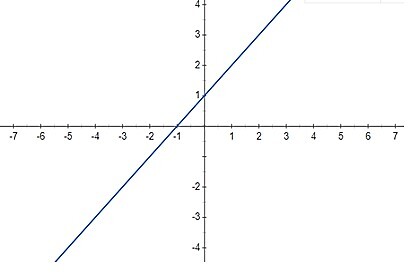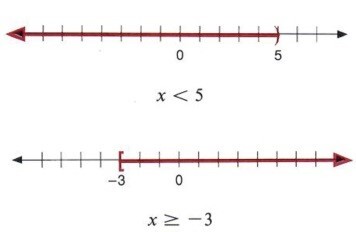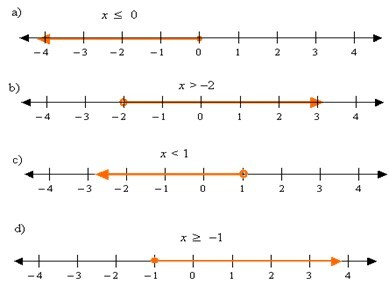
 Data Structure
Data Structure Networking
Networking RDBMS
RDBMS Operating System
Operating System Java
Java MS Excel
MS Excel iOS
iOS HTML
HTML CSS
CSS Android
Android Python
Python C Programming
C Programming C++
C++ C#
C# MongoDB
MongoDB MySQL
MySQL Javascript
Javascript PHP
PHP
- Selected Reading
- UPSC IAS Exams Notes
- Developer's Best Practices
- Questions and Answers
- Effective Resume Writing
- HR Interview Questions
- Computer Glossary
- Who is Who
Represent Linear Inequalities In One Variable On Number Line
Introduction
A linear equation is a type of equation in which the order of each variable in the equation is exactly one. A one-variable linear equation is an equation with only one variable and one solution to the equation. When drawn on a chart, it will appear as a straight line horizontally or vertically. Any variable or symbol can be used to represent an unknown, but the variable "x" is typically used to represent an unknown in a linear equation of one variable. There are several easy ways to solve a linear equation. Constants are separated on one side of the equation and variables are separated on the other side of the equation and then simplify to get the final answer.
A single variable linear equation is the basic equation used to represent and solve an unknown quantity. It's easy to represent graphically and is always a straight line. Linear equations are a simple way to represent mathematical statements. In this tutorial, we will discuss Represent Linear Inequalities In One Variable On Number Line.
Linear Inequalities
A sentence that equates two mathematical expressions is known as an algebraic equation. The largest exponent of a variable in a linear equation, which is a first- degree equation, is 1. A linear equation with one variable has the conventional form $\mathrm{ax\:+\:b\:=\:0}$, where x is the variable. This indicates that a linear equation's variables lack exponents like squares or cubes. It is an equation or an inequality, has a single unknown variable, and produces a straight line pattern rather than a parabola or any other non-straight curve.
Here is an illustration of a linear equation, $\mathrm{y\:=\:2x\:+\:3}$, represented as a straight line on a graph.

Here is a further graph that displays an inequality graph. This graph's red line indicate the graph of $\mathrm{}x\:<\:5\:and\:x\:\geq\:-3$

Linear Inequality in one Variable
It is similar to an algebraic linear equation, but with an inequality sign in place of the equal sign. When there is inequality, LHS and RHS have a different connection, such as greater than or less than, in place of equality. Example When x <10, there is inequality between the left and right hand sides. Here is a case of inequality where RHS is greater than LHS.
The symbols "<" and ">" stand for strict inequalities, while "?" and "?" stand for slack inequalities. The examples of linear inequalities in one variable include ?? + ? > 0, ?? + ? < 0, ?? + ? ? 0 ??? ?? + ? ? 0.
Note What you have learnt thus far about solving linear equations will also be used to solve inequalities. The only distinction is that you must also reverse the inequality sign when multiplying or dividing by a negative number.
Representation of Linear Inequality on a Number Line
Linear Inequalities in One Variable: Algebraic Solutions
Different kinds of linear inequalities are known to us. Let's examine the inequalities and their solutions.
Take the linear inequality as an illustration. When x is a whole number, 3x <6.
The inequality's RHS is six and its LHS is 3x. When x = 0,
$\mathrm{RHS\:=\:6\:,\:LHS\:=\:3\:\times\:0\:=\:0}$
Since 0 is less than 6, the inequality is satisfied by x = 0. When x = 1,
$\mathrm{RHS\:=\:6\:,\:LHS\:=\:3}$.
Since 3 is less than 6, the inequality is satisfied by $\mathrm{x\:=\:1}$.
$\mathrm{When\:x\:=\:2}$,
$\mathrm{RHS\:=\:6\:,\:LHS\:=\:6}$
Since 6 cannot be smaller than 6, the inequality will not be satisfied by x = 2. It is known that in order to meet the inequality, x must be less than 2.
"Solutions of the inequality" are values of the variable that make the statement true.
As a result, the above inequality has solutions of 0 and 1, which are referred to as the solution set.
Linear Inequalities Rules
Rule 1 The sign of an inequality will not change if we add or subtract an equal number from each side.
Rule 2 The inequality can be divided or multiplied by the same positive value on both sides. If both sides are multiplied or divided by a negative number, the sign of inequality is flipped.
Draw the graph of $\mathrm{\lbrace\:a\:\rbrace\:x\:\leq\:0\:,\:\lbrace\:b\:\rbrace\:x\:>\:-2\:,\:\lbrace\:c\:\rbrace\:x\:<\:1\:,\:\lbrace\:d\:\rbrace\:x\:\geq\:-1}$

Solved Examples
Example 1 Solve $\mathrm{2x\:+\:4\:\leq\:10}$ and, if x is positive, represent it on a number line.
Solution: Given equation is $\mathrm{2x\:+\:4\:\leq\:10}$
Now separate the variable and constant that is subtract four from both sides,
$\mathrm{\:\:\:\:\:\:\:\:\:\:\Longrightarrow\:2x\:+\:4\:-\:4\:\leq\:10\:-\:4}$
$\mathrm{\:\:\:\:\:\:\:\:\:\:\:\:\:\Longrightarrow\:2x\:\leq\:6}$
On dividing both side by 2 we get
$\mathrm{\Longrightarrow\:x\:\leq\:3}$
Since x is positive (given) so x is larger than 0 and less than or equal to 3, or
$\mathrm{x\:\varepsilon\:(0\:,\:3]}$
which can be represented as

Example 2 Solve $\mathrm{2x\:+\:6\:<\:12}$ and represent on graph
Solution Given equation is $\mathrm{2x\:+\:6\:<\:12}$
Now separate the variable and constant that is subtract six from both sides
$\mathrm{\:\:\:\:\:\:\:\:\:\:\Longrightarrow\:2x\:+\:6\:-\:6\:<\:122\:-6}$
$\mathrm{\:\:\:\:\:\:\:\:\:\:\:\:\:\:\Longrightarrow\:2x\:<\:6}$
On dividing both side by 2 we get
$\mathrm{\Longrightarrow\:x\:<\:3}$
This inequality can be represented as

Conclusion
A linear equation is a straight-line equation in which the variable's power is one. It is written as ?? + ? = 0, where a and b are integers and x is a variable. An assertion of comparison between two expressions is called an inequality. The inequality symbols, <, >, ? ?? ? are used to compare the values of two expressions in linear equations. There is only one solution or one root for one- variable linear equations and equations.
FAQs
1. What do you mean by a linear equation with one variable?
Ans. A linear equation with one variable is a straight-line equation in which the variable's power is one. It is written as $\mathrm{ax\:+\:b\:=\:0}$
2. What do you mean by linear inequality?
Ans. It is similar to an algebraic linear equation, but with an inequality sign in place of the equal sign.
3. What are the inequality symbols?
The inequality symbols, <, >, ? ?? ? are used to compare the values of two expressions in linear equations.
4. What is the degree of linear equation?
The degree of the linear equation is one.
5. What are the main differences between linear inequality and equality?
The only thing separating an inequality from a linear equation is the sign. In a linear equation, two expressions are compared whereas in a linear inequality, two expressions are equated.

